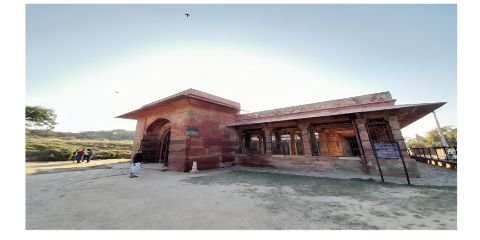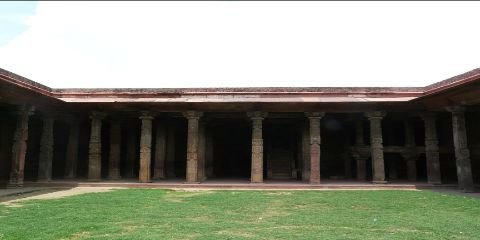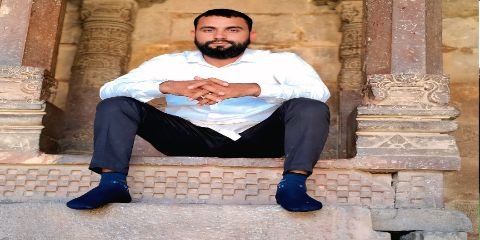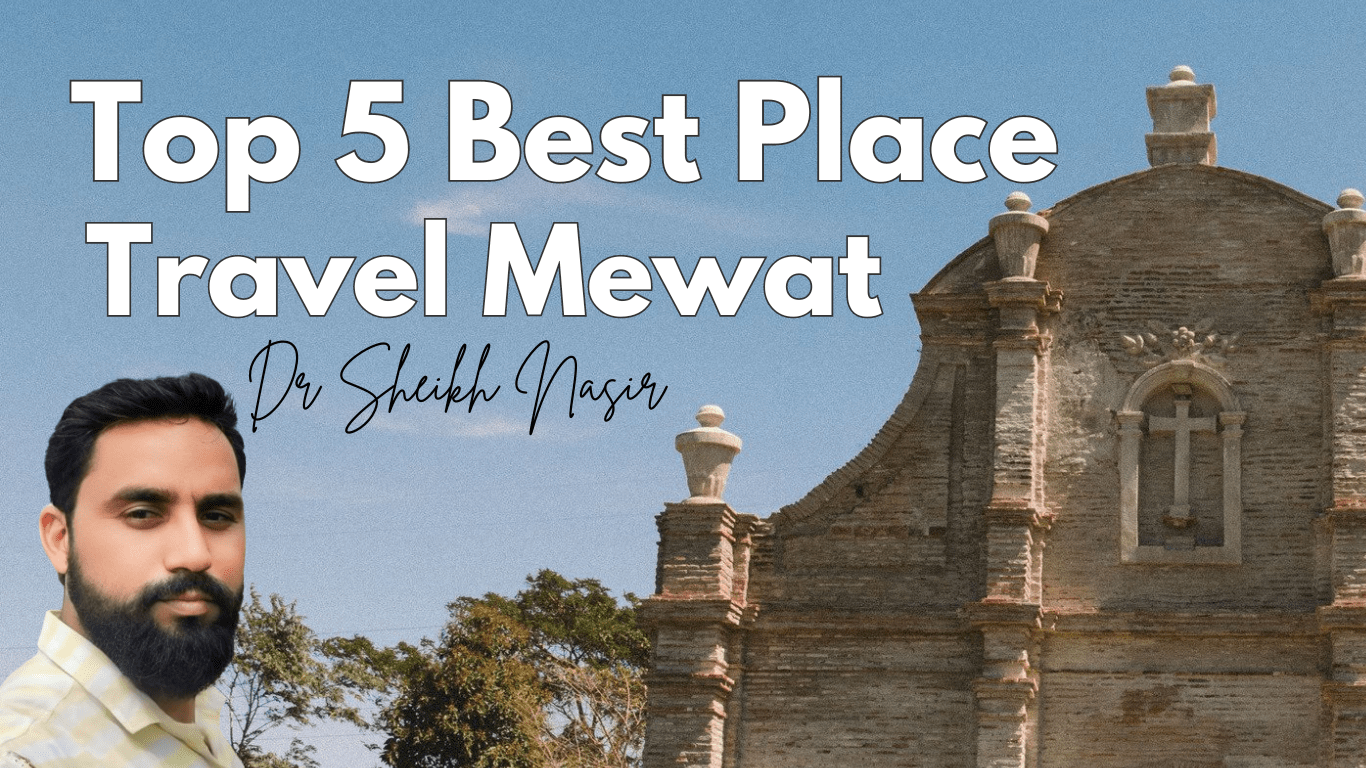Itrodyction of Kaman ke 84 Khambha: The history of Rajasthan is recorded in the glorious pages of India. Amazing examples of bravery, culture and architecture can be seen here. One of these places is Kaman ke 84 Khambha – which today comes in Deeg district of Rajasthan and is historically an important part of Mewat. Mewat extends to Haryana, Rajasthan and Uttar Pradesh and this area is known for its unique cultural heritage and architecture.
The identity of Kaman town is a unique and mysterious building – the 84 pillared mosque (Chaurasi Khambha). This building is as beautiful as it is mysterious. Whenever someone goes here, he gets to hear different stories – someone says that it was built by Vishwakarma, someone calls it the miracle of Jinns, while someone connects it to the Pandavas. When we also visited here, we saw that people tell their own beliefs and stories. But the truth is that most people are unaware of the real history of this historical heritage and believe the hearsay to be true.
Kaman ke 84 Khambha is not just a religious place but a great example of Mewat architecture and is deeply connected with Meo history. This building not only instills faith in the hearts of the local people, but also leaves many questions for historians. This is the reason why today hundreds of tourists come here to visit and are amazed to see its beauty. But the real fun is only when we understand the real historical truth behind it, apart from the hearsay.
Kaman ke 84 Khambha – what is the truth behind it?

Kaman ke 84 Khambha still remains a mystery for people. When someone goes here, he gets to hear different things – someone says that it was built by Vishwakarma, someone says that it is the work of Jinns or demons, while someone associates it with the Pandavas. But the truth is that this building is actually a mosque, which historians know as 84 Chaurasi Khambha Mosque. Its biggest feature is that it has a total of 84 pillars and it got its name from these pillars.
Another mystery always amazes people – whenever someone sits down to count the pillars, often he is unable to count them completely. This thing further increases its mysterious image.
If we look at history, it is not a supernatural construction but a mosque built by Bahaud‑Din Tughrul. Tughrul, who was the Ghurid governor of Bayana region, got this building constructed around 1192–1193 AD. Stones and pillars obtained from temples were reused in it. This is the reason that even today broken marks of craftsmanship and idols of old Hindu temples are visible on many pillars.
Therefore, Kaman ke 84 Khambha is not only a religious place but also a unique confluence of Indian architecture and Islamic architecture. This place is not only associated with the history of Mewat (Meo history), but is also a great example of Mewat architecture.
But the number 84 itself becomes a mystery.
The most famous mystery about Kaman ke 84 Khambha is that no one can count these pillars accurately. Local people believe that no matter how many times you count, the number comes out different every time. This is why it is also called “pillars beyond count”.
1. Local belief – symbol of 84 castes
According to folklore, these pillars are a symbol of 84 castes or communities. It is believed that if someone counts them, then this task will never be completed, because the castes of the society also never end. This is the reason why people believed that it is not possible to count the pillars.
2. The story of the Jinn
The second story says that this mosque was built by the Jinns in one night. When it was morning and the women started grinding the flour mill, the Jinns left the work incomplete. This is why people say that this building is mysterious and the count of its pillars is never complete.
3. The real reason behind the architecture
If seen from the point of view of history and architecture, there can be a practical reason behind it.
Many pillars in the mosque are of small and big sizes.
Some pillars are half connected to the walls inside.
There is confusion in counting some pillars because there are rows of pillars in both the courtyard and the prayer hall.
Because of this, when someone counts, its sequence changes every time and the total number never remains constant. This is where the belief was formed that “84 pillars cannot be counted.”
4. Opinion of historians
Shokoohy (1987) and ASI reports believe that the number of pillars here is actually around 84, but the “exact count” varies due to architectural structure and wear and tear of the pillars.
Many pillars are reused pillars brought from temples, some of which are still broken today.
The structure of the mosque – history written in stones

If you look carefully at Kaman ke 84 Khambha, you will find that many of its pillars and walls have a glimpse of old temples. Even today, marks of broken idols and craftsmanship are present on these stones. This makes it clear that this mosque was built from the remains and pillars obtained from the surrounding temples.
But it is very important to understand one thing here – this mosque was not built on top of any temple by demolishing it. At that time Islamic architecture was completely new in India, while Hindu and Jain architecture had been prevalent for centuries. Therefore, to build the mosque, stones and pillars of already existing temples were collected and used here.
- 👉 This is the reason why many pillars show a glimpse of Hindu style, but the entire structure is of Hindu style. Nor was it built as an Islamic mosque.
- 👉 This was the same period when the Delhi Sultanate had not even started. And the kings of Mewat around here
Even during the Mughal period, many buildings were built from the stones of old structures. This also gives us a glimpse of the social and religious conditions of that time. It tells how the old and the new merged in architecture.
So today when someone sees Kaman ke 84 Khambha, on one hand he remembers temple art and on the other hand he also gets a glimpse of early Islamic architecture. This combination makes it even more important from a historical point of view.
My own thought – the real meaning of 84 pillars?

When I, Nasir Hussain (Nasir Hussain Organization), reached Kaman ke 84 Khambha, the atmosphere there was something different. Each pillar stood with its own identity – as if it was saying, “I am present here, I am standing with a different story of my own.” To be honest, I felt as if each pillar contained a unique history within itself.
The boundary wall of this mosque, its square courtyard, the huge door and the remains behind it – all together tell a story that is not fully recorded in the books. The most beautiful thing I found was its arch and the other arch built next to it. This arch reminds me of the Iraqi and Islamic architectural style of the sixth-seventh century. At that time when this mosque would be inhabited, every person coming here would return with a different spiritual feeling.
The thought came to my mind that these 84 pillars probably symbolize 84 castes and communities. Because when I read and heard about Mewat, everything seemed to be connected to “84” somewhere – 84 ponds, 84 temples, 84 clans, 84 hectares of land. Perhaps that is why this mosque was also built with 84 pillars. I think Baha‑ud‑Din Tughrul built it not only as a place of worship but also as a symbol to unite all 84 communities at one place. That is, this mosque is a symbol of both Mewat architecture and unity of society.
Unfortunately, today this place is not fulfilling that purpose. Today people are divided here, and many folklore and fabricated stories related to this mosque have overtaken the real history. I noticed that bloggers or YouTubers who come here often exaggerate the stories heard from people, but hardly anyone wants to find and tell the real history.
And perhaps this is where a thread of the beginning of Meo history connects – who knows these pillars may be the first testimony of the unity and diversity of those communities?
History and Mystery – A Confluence of Both

Kaman ke 84 Khambha is not just a mosque, but it is a confluence of history, mystery and faith. Built in this small town of Kaman in Bharatpur district of Rajasthan, this structure contains within itself a glimpse of an entire civilization and that era.
Historians consider it to be one of the most unique and early buildings of the Sultanate period. It was built by the Ghurid governor Baha‑ud‑Din Tughrul around 1204 AD. The pillars and stones used here were brought from old temples, so we see a wonderful combination of Mewat architecture – where there is a glimpse of Hindu and Jain craftsmanship as well as the early identity of Islamic architecture.
Local people associate it with faith and mysterious stories. Some say that it was built by Jinns in one night, while some consider it a symbol of 84 castes. This is the reason why it remains a puzzle for people even today.
When tourists come to this place, they are fascinated by the architecture and the beauty of the pillars. From my point of view, this building is a symbol of the beginning of Hindu-Muslim culture of that era, when despite religious diversity in the society, the color of the common culture was deep.
Whether people call it “84 Khambha” or “Kaman ke 84 Khambha,” the truth is that this place is unique in itself – a heritage that gives an opportunity to understand both Meo history and Indian history in depth.
Conclusion Kaman ke 84 Khambha

Kaman ke 84 Khambha still attracts every visitor. This place is not just a place of worship, but a confluence where history, religion, architecture and folklore all meet together.
- 👉 If you visit Rajasthan, then definitely visit this corner of Bharatpur.
- 👉 And yes, whenever you try to count these pillars, keep in mind – maybe you too will not be able to complete 84. 😉
❓ Frequently Asked Questions (FAQ)
1. Who built Kaman ke 84 Khambha?
They were built by the Ghurid governor Baha‑ud‑Din Tughrul around 1204 AD.
2. Is it true that the pillars were built by Jinns in one night?
No, this is just a folklore. The real history says that this mosque was built with pillars brought from temples.
3. Why are there only 84 pillars in it?
The number “84” is considered special in local traditions. It is believed that it is a symbol of 84 castes. Also, the symmetry of the pillars in architecture is such that the count often goes wrong.
4. Is Kaman ke 84 Khambha the oldest mosque in India?
No, the oldest mosque in India is Cheraman Juma Mosque in Kerala. But this mosque in Kaman is one of the earliest Sultanate‑era mosques in North India.
5. Is this mosque related to Meo history?
Yes, this building is considered an important part of Meo history and Mewat architecture. It has a strong connection with the Meos who were settled by Tughrul and later converted to Islam.
Local Oral Traditions & Field Observations – 84 Castes, 84 Ponds and Folktales (Personal study and local interviews by Nasir Hussain Organization).


